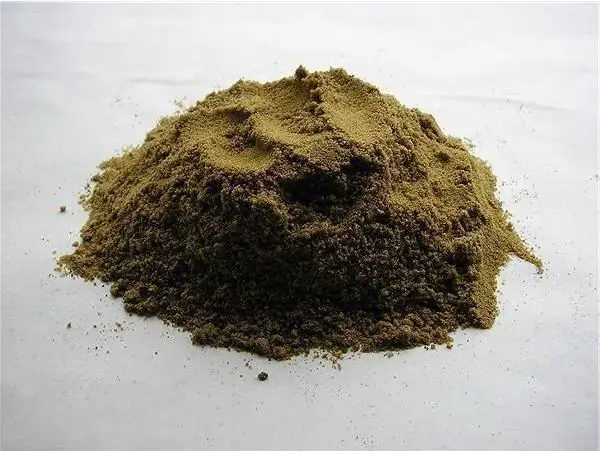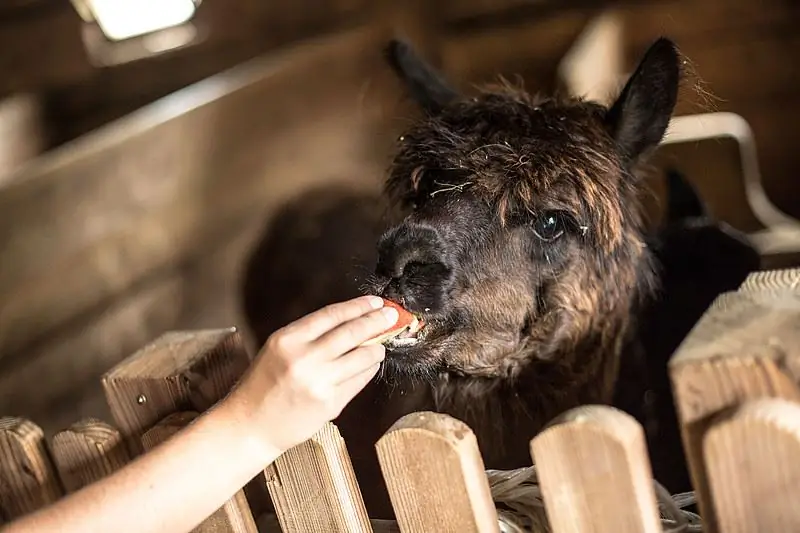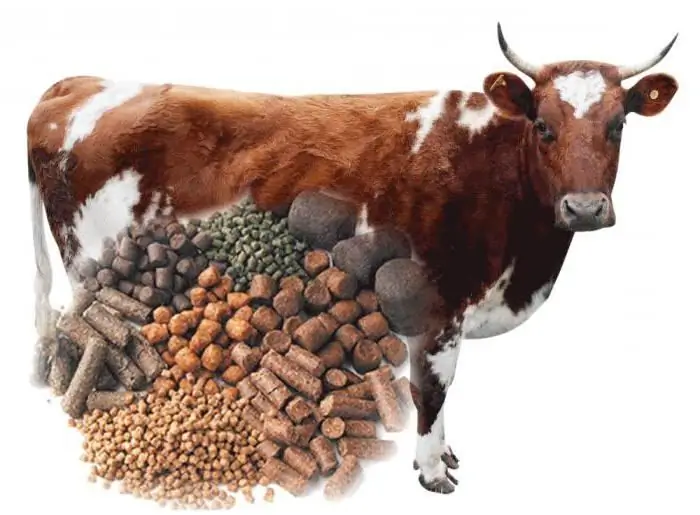2026 Author: Howard Calhoun | [email protected]. Last modified: 2025-06-01 07:12:56
Feed grains are cereals intended for feeding farm animals. Forage is the basis of diets in poultry and pig breeding, as well as a valuable component in cattle breeding. Such crops cannot be used for food purposes.

Benefits of forage
Feed grain is a very valuable and useful product for animals. It is endowed with all the necessary vitamins and microelements for the full development and growth of livestock and poultry. In addition, cereals contain a lot of carbohydrates, protein and amino acids. The forage also has a high energy value. The price of fodder is lower, which can significantly reduce the cost of livestock products.
Common types of cereals
Among the feed grains, the following crops are most common:
- Grains - wheat, rye, oats, corn, barley, millet.
- Beans - beans, peas, chickpeas, beans, lentils, soybeans.

Forage wheat
Wheatis not only the most important food, but also forage crop. Almost half of the entire crop is spent on feed needs.
This is a herbaceous annual plant, 50-150 cm high. It happens in winter and spring. Today there are many varieties of wheat. Conventionally, they can be divided into hard and soft types. Durum wheat varieties have a thick-walled straw filled with a dense mass on top near the ear. In soft cultures, on the contrary, the straw is thin-walled and hollow along the entire length.

Grain classes
Depending on the quality, according to GOST, hard and soft wheat varieties are divided into different grain classes.
Hard grains have 5 divisions, and soft grains have 6. All classes except 5 and 6 are used for food purposes.
- The highest, 1st and 2nd class of wheat belongs to strong varieties that can be used both independently and as an amplifier of weak varieties in baking.
- 3 class is considered very valuable. In the food industry, it is used independently and does not need improvement.
- 4 Grade wheat can only be used in the food industry and bakery after it has been improved with higher grades.
- 5-6 classes of wheat grains are "forage".
Gradation by quality classes in this standard is carried out in terms of gluten, moisture, protein (except class 5), density, pest infestation, harmful, grain and weed impurities.
When determining the quality of forage grain, it is taken into account, firstin total, the level of its condition (content of dry matter, crude protein, metabolic energy, crude fiber, phosphorus, calcium, etc.).

Forage wheat grade 5
Class 5 wheat is non-food, therefore it is intended for fattening domestic animals and the production of animal feed. In its composition, it practically does not differ from food. However, if for grain intended for food purposes, a high percentage of starch and gluten is considered an advantage, then for animal feed it is rather a disadvantage. Therefore, feed wheat in the feed of small and large cattle, pigs, sheep and poultry (ducks, chickens, geese) serves only as an additive to the main diets and is not used as mono-feed.
- For chickens, grain is prepared by grinding, sprouting or yeasting, and may not exceed 60% of the total feed.
- The amount of feed grain in the diet of cows is calculated depending on the weight of the animal and milk yield, and can be close to 30% of the total nutritional value of the feed.
- For fattening pigs, the optimal amount of wheat in the feed is 20-40%.
Indicators of feed wheat
There are mandatory quality requirements for forage. So, fodder wheat GOST R 52554-2006 must be he althy, not infested with pests and have an industrial value. In the composition, the presence of grain impurities up to 15%, weed impurities - 3%, germinated grains no more than 2% is permissible. Humidity should not exceed 15%, By protein contentfodder wheat exceeds all other cereal crops, in addition, it is a high-calorie feed, second only to corn. The grain contains 10-15% proteins, a small amount (up to 2%) fats, 2-3% sugar, up to 65% carbohydrates, which are mainly represented by starch. There is also a complete set of essential amino acids, vitamins of groups B, E, PP, trace elements - potassium, phosphorus, magnesium, sodium.

The benefits of feed wheat
First of all, fodder wheat is a valuable food product, which contains many useful micro- and macroelements, lysine, amino acids, phosphorus, which favorably affect the development and he alth of livestock. The soft variety is used to feed finicky animals and birds. Feed wheat (price 7500 - 8500 rubles/t) is considered more popular than other forage crops due to its affordable cost, taste, nutritional value and useful properties. Used as feed for practically all types of agricultural livestock and poultry.
Animals fed with this food gain weight and height well and produce he althy offspring.
Flaws
The disadvantage of feed wheat is the high content of gluten and starch, which in the stomach of animals form a sticky mass that can cause pain and colic in the abdomen. In addition, excessive consumption of wheat by forage cattle can lead to obesity, which increases the risk of developing various diseases. Therefore, it is necessary to carefully monitor the dosage of all feeds so that your household does notharm.

Feed corn (grain)
Corn is the queen of the fields. Its feeding value is 1.34 feed units. According to GOST 13634-90, corn is divided into three classes, depending on the percentage of damaged grains and grain impurities. The third class of this crop is used for animal feed. The maximum allowable percentage of grain impurities for this class should not exceed 15%, and the amount of germinated grains should not exceed 5%. Depending on the color and type of grain, this crop is divided into 9 types, each of which can be used for fodder purposes and the production of animal feed.
Forage barley
Grade 3 barley, or forage barley, like corn, is the main fodder crop included in the diet of large horned animals. It is rich in amino acids and lysine. It is considered the most cost-effective crop. Suitable for all agricultural pets. Almost everyone loves it - cows, horses, pigs and even rabbits. Feed value reaches 1, 2 feed units. The quality of fodder barley is regulated in GOST 28672-90.
Fodder oats
The quality of oats is determined according to GOST 28673-90. This culture is divided, depending on the grain impurity, into four main classes. Oats, which contain from 12 to 15% of grain impurities, belong to the fourth (forage) class. Of all grain crops, the oat weight is the lowest at 460 grams/litre.
Recommended:
Fodder grain: quality and storage. How is feed grain different from regular grain?

The development of animal husbandry makes it necessary to increase the amount of feed for livestock. According to statistics, about half of the total average annual grain harvest is spent for these needs. At the same time, 15-20 million tons of this mass falls on wheat. To reduce the cost of livestock products, instead of more expensive food cereals, feed grain is used
Forage crops: cereals, legumes. List of forage crops

This article tells you which plants are the most suitable for use as animal feed. Cereals, legumes, as well as gourds forage crops are described here
Grass and hay flour. Feed for farm animals

Grass flour is one of the best feeds for farm animals and poultry. In terms of nutritional value, it surpasses hay and silage by several times, the content of proteins and vitamins in it is much higher than in grain mixed feed
Mine grain dryer: device, principle of operation. Grain drying equipment

The task of any grain drying equipment is to provide high-quality blowing of grain and oilseeds to reduce moisture. This allows you to store the product for a long time. Shaft-type grain dryers are currently in great demand. They provide uniform and stable blowing of the grain
How to build a farm: farm animals, fundamental differences in construction and planning

Housekeeping has great prospects. However, to achieve any success, it will take a lot of effort and time. Since in our country farms have good support from the state, if you do business correctly, you can get a good income. In addition, agricultural products have always been and will be in great demand both in domestic and foreign markets

